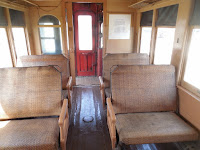 The 36 was the last of our four operating cars to be inspected in 2015. (That's the nice thing about cars like the 205 and the 150 -- they don't require all this onerous work every year.) It took all day Tuesday but no problems were found. I was too busy to take any pictures of the inspection, but the weed-spraying truck was here for its annual visit.
The 36 was the last of our four operating cars to be inspected in 2015. (That's the nice thing about cars like the 205 and the 150 -- they don't require all this onerous work every year.) It took all day Tuesday but no problems were found. I was too busy to take any pictures of the inspection, but the weed-spraying truck was here for its annual visit.
Note the grading that has been done in yards 14 and 15.
Today I finished painting the roof of the 36 early in the morning, but it was too hot and humid to continue with the letterboard as I would have liked. So I cleaned up the interior for revenue service. It badly needed vacuuming and so on.

Here is the main compartment.

Looking out the "solarium" end:
And, of course, the repainted smoker.
Since only one side is lettered, I needed to turn it around, and today was a good opportunity. It also gave me a chance to take some pictures of the 36 at historic locations....
Here we are making a station stop along the Cook County branch.


And approaching Batavia.
I also got to do some consulting work on the Charles City engine. The question arose as to how the DB-102 circuit breaker is supposed to function, and what the purpose of the DB-597 relay might be. Because this is a dual-voltage system, it has several unusual features, but I believe we have it all worked out now. I'd like to get a good scan of the (nicely framed) diagram, but for now this photo works pretty well.







2 comments:
Randy,
Considering that this wooden Interurban was built in 1902; she is looking pretty good!
I wonder what the builders would thing of their work over 100 years later!
Ted Miles
IRM Member
I have often wondered the same thing, Ted. I don't know that the builders ever specified what the useful life of a wooden electric car was supposed to be, but if the electric railway industry had been as profitable as everybody expected in 1902, they would have been replaced in less than twenty years, maybe much less. And the CA&E cars like the 36 were thought to be coming apart after ten or twelve years of use, so they were heavily rebuilt with steel reinforcements to the framing. That undoubtedly prolonged their existence. After that, a substantial maintenance program was necessary to keep them running. Still, the ability of these cars to operate for well more than a hundred years is pretty amazing.
Post a Comment